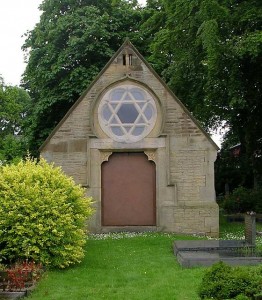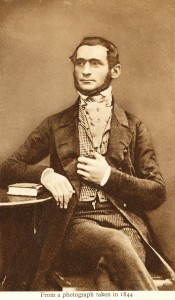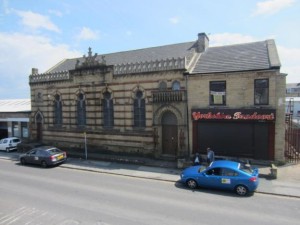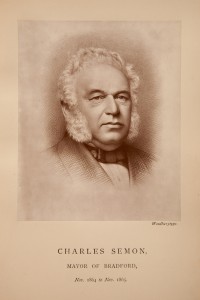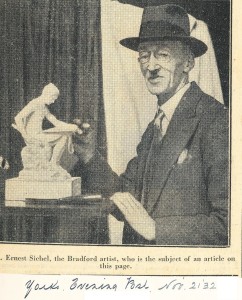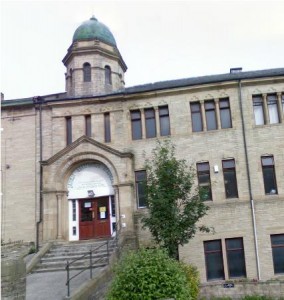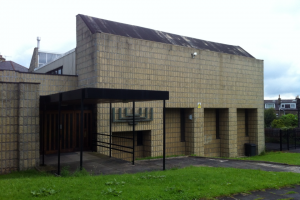The Faces Of Jewish Bradford Over The Years
- L-R: William Rothenstein, Solomon Selka, Humbert Wolfe, Ernest Leopold Sichel, Jonathan Silver, Harry Behrens, Louis Bookman, Dr David Black & Albert Ruthenstone

L-R: Jacob Moser, Charles Semon, Rabbi Joseph Strauss, Olive Messer, Rabbi Erich Bienheim, Jacob Behrens and Florence Moser
This information has been reproduced from the JTrail Website run by Northampton based Jewish Historian Marcus Roberts.
The following text has been written by Nigel Grizzard and Marcus Roberts.
Bradford has a proud history. It was the wool capital of the world (a trade which originated in Yorkshire in the 14th century, based on the Cistercians and their superior woolly sheep), and part of the cradle of the Industrial revolution – a city full of ‘Yorkshire grit’. These are some of the titles that apply to Bradford. However, at first glance the Jewish connection to Bradford seems a strange one.
While the Leeds and Manchester Jewish community grew as part of the migration of Russian Jews escaping from tsarist Russian persecution in the 1880s and 90s, Bradford was part of an earlier settlement from the 1820s onwards, part of a commercial venture of Germans, both Jewish and Gentile.
German Jews who came to Bradford from the 1820s onwards, came not to seek freedom from persecution, but to build businesses and fortunes. They did much to shape Bradford and to create its wealth and fame. They were passionately concerned in the building of Bradford and helped change a small town into a major commercial city. They made an indelible mark on its industrial as well as cultural and charitable life. Many who later left Bradford enhanced the general quality of life in Britain, among them were proud Jews concerned for their own community and the welfare of Anglo Jewry. Some were directly involved in the laying of the foundations of the Jewish State Israel in what at the turn of the century was a forgotten province of the Turkish Empire.
So, while the casual visitor to Bradford will not see much of Bradford’s Jewish heritage without being guided to it, there are probably more historic monuments to Jewish endeavour in Bradford than in Leeds and this guide will help you find it.
Who Were the First Jews in Bradford?
Jewish settlers arrived in Bradford in the 1820s and 30s. They were not itinerant peddlers looking for a good operating base as were Jewish settlers in other towns. They were not fiercely religious and Orthodox, as were the peddlers from Poland or Russia. On the contrary, many were already successful middle-class and educated German Jews who were products of the German Jewish Enlightenment and who saw themselves as both Germans and Jewish.
In the Journal of Dr John Simpson of Bradford 1825, who was Bradford’s equivalent to Dr Samuel Johnson of London, there is the following entry for May 4th, 1825.
‘Mr Jacobs, the jeweller called upon me today, but not being in want of anything I did not purchase. He is not one of the common travelling Jews, but is on first name terms with the first families in the county. The Earl of Harewood has been a good customer of his for several years. He comes to Bradford twice a year, but only calls on those to whom he is recommended. His articles are good and you give a good price for them in the first instance, but you may depend upon them being genuine and if they disappoint he will take them back. I bought off him about two years ago, the gold watch, chain and seal I now have. I gave thirty six guineas for the watch, eleven guineas for the chain, and two guineas and a half for the seal…’
It seems likely that Mr Jacobs came from London; if he had lived in Manchester, he would presumably have visited Bradford more than twice a year. Dr. Simpson mentions an earlier visit in 1823 (about two years earlier) and this is possibly the first reference to be found to Jews in Bradford.
Since Jacobs was not the first permanent Jewish resident of Bradford, the question of who was the first settler is a difficult one. In fact there are several contenders. The Jewish Chronicle Supplement (1 July 1955) suggests a Martin Hertz, who arrived in Bradford was the first resident. C.C. Aronsfeld, of ‘Yorkshire Life, (June 1978), gives Leo Schuster, who opened premises in 1829 on the present site of the Norfolk Gardens Hotel. Yet Williams, the historian, claims in, ‘The Making of Manchester Jewry 1740 — 1875′ (1976) that Schuster was already converted to Unitarianism. Finally, Heilbron, who wrote in, ‘Provincial Jewry in Victorian England’; suggests that the first Jew who came to Bradford in modern times was Jacob Behrens (See later) in 1838.
The Forming of a Jewish Community
From the 1840′s onwards there was a steady trickle of Jewish immigrants into Bradford mainly attracted by the textile industry. The Bradford textile industry was a great draw as its productions of worsted, mixed fabric and silks were very popular on the continent. In 1934, the ‘Yorkshire Observer’, looking back commented that some of these early incoming Jews had the ‘Spice of Adventure’, by which was meant that, despite not possessing a great deal of technical knowledge, they were prepared to work together, ally their powers and take risks in the hope of achieving success and status.
Even though Jews were in Bradford from the 1820s, there was exceptionally, no organised religious life in the town until the formation of a Jewish Association in Bradford as late as 1873. This all the more remarkable as the town has already has a Jewish Mayor, in Charles Semon, as early as 1864.
In 1865 there was a sufficiently large number of Jews in Bradford for the Chief Rabbi to include Bradford in his provincial tour, but only six people attended a meeting convened to talk to him! The Jewish Chronicle noted that there were over 100 children in the Jewish community but no facilities for their Jewish education.
The Bradford Jews were noted for their assimilation and lack of religious life. Bill Williams the historian, commented that, ‘religious life was almost totally corroded, circumcision was rare’ a view backed up by the Jewish Chronicle, of August 11th 1865, which related that the Jews of Bradford, ‘… do not want to pass for Jews although every child in Bradford knows them to be Jews’.
The Chief Rabbi again visited Bradford in 1870 and attempted to form a Jewish Association with very little success. The Jewish Chronicle reported in 1871 that services were held in Bradford on the High Holidays and only between 30 40 people attended. At this time the Jewish community numbered between 200 300 people; a sizeable community yet one without services or a synagogue.
Bradford Jews, were a product of the liberal philosophy and values of German society that had eroded the hold of traditional Orthodox Jewish religion and created a class of assimilated and secular Jews, or Jews who followed a Reform Jewish ritual.
Many German Jews’ clearest affiliation was with the general German community and its culture. The German community up and down this country largely organised themselves around a series of German institutes (Vereinen). In Bradford there was the Schiller Institute, the Schiller-verein, where the German elite met and socialised. One oral traditional passed on by Oswald Strauss, the son of Rabbi Strauss, was that the Jewish merchants alleviated the very exceptional late hours they worked, by having long liquid lunches at the Schiller-verein on Manor Row, after which they would return to their business premises, sleep off the liquor, and return to work.
Some of the more religious of the Bradford Jews had already joined synagogues in Leeds and Manchester where they attended services on the High Holidays Rosh Hashanah (New Year) and Yom Kippur (Day of Atonement). This fact was noted in the document placed in the foundation of the Bradford Reform synagogue when it was opened. German Jews usually joined the existing synagogues of their English or European co-religionists.
In 1872 there were moves to establish a ‘Reform’ congregation in the West Riding of Yorkshire; there already was an Orthodox Community in Leeds. The Reform branch of Judaism had its origins in Germany. The Reform ritual included much more English in the services and some of the strict religious code of Judaism is not found in Reform theology. Three towns – Huddersfield, Leeds and Bradford – were considered as possible venues for the congregation, but Bradford was chosen.
This was an event of some interest as this synagogue for German Jews was one of only two synagogues, specifically for German Jews in the entire country. The only other German Jewish synagogue was established in Dundee.
On 1 April 1873, at a meeting in Bradford, chaired by Charles Semon, ‘The Jewish Association of Bradford’ was formed. The aims of the Association were the, ‘up-holding and advancing the cause of Judaism and providing for the religious teaching of the Jewish children.’
The first act of the newly formed Jewish Association was to make a request to the Grand Rabbi of Stuttgart to assist the congregation in finding a Minister. Rev. Dr. Joseph Strauss aged 28 and with a Rabbinic diploma was appointed as the first Rabbi in Bradford. Rabbi Strauss was welcomed by the community at a general meeting on October 31st, 1873 and next day gave his first sermon. In his memoirs he noted that the older and wealthier Jewish families were indifferent to their religion perhaps a reason why it took so long to form a community.
Rabbi Strauss first instituted regular services on Sabbath and festivals which were held in the Masonic Chapel, Salem Street and later in the Unitarian Chapel, Town Hall Square. He then raised, through the community, a sum of £800 to purchase a separate plot in the Scholemoor Cemetery for a Jewish burial ground. Classes were also given to teach the young children about Judaism and the Hebrew language.
In 1876, Rabbi Strauss was appointed lecturer in Hebrew and Oriental languages at the Airedale Independent College, Bradford. He later went to Yorkshire College now Leeds University.
He was also an influential Zionist figure and in 1898, he appointed delegates to the Second Zionist Congress in Basle. He would often take advantage of opportunities to explain Zionism to his co-religionists, despite hostility to the movement.
The Franco Prussian war, of 1870 71, interfered with the woollen trade between Germany and France. Many German Jewish merchants then transferred their headquarters to Bradford and their impressive warehouses, largely situated in an area of Bradford that became known as ‘Little Germany’, placed them as close to the supply of the textiles they traded in as they could be. The population of Bradford rose to over 200,000 by the 1880′s but the middle and upper class ruling elite of mill-owners, industrialists and entrepreneurs would have been comparatively small. The Jewish merchants who comprised over 100 families were able to make a great mark on the city.
Famous German Jewish Merchants
Among the German Jewish merchants several names stand out. Jacob Behrens (1806 1889) was the first foreign merchant to export wool goods from Bradford. He was born in Pyrmont, Waldeck, Germany, and was brought up in Hamburg, the son of Nathan Behrens. When he arrived in the town he lodged at the Sun Inn at the bottom of Ivegate, but left his lodging because he was told, ‘he could not stay as he took nothing to drink.’
His business grew into a multi million pound empire with branches in London, Glasgow, Calcutta and Shanghai. He was knighted in October 1882 by Queen Victoria for his work in connection with commercial treaties between England and France. His name can still be seen, cast in iron, above the entry to his warehouse.
Behrens also had interests out-side of business and was recognised in his obituary as, ‘…a gentleman of culture and a philanthropist’. He was very active in promoting education in Bradford. He was significant in re-organising Bradford Grammar School in 1871 and he was very important in setting up the Technical College, in Great Horton Road, in 1882.
Jacob Unna (1800 1881), one of Bradford’s leading industrialists and an important developer of the Bradford worsted trade and originally represented the Behren’s concern. Unna was born in Hamburg and came to Manchester in 1820, moved to Leeds and settled in Bradford in 1844. In 1836 Unna returned to Hamburg to marry his cousin Serina Salomon and I have seen a copy of the Ketubah (Hebrew marriage certificate) in the possession of his great grandson Mr. Charles Russell. Unna (with Behrens) was a founder of the Bradford Chamber of Commerce in 1851. This was part of an efficient marketing system that was vital to the success of the Bradford merchants. He was also a leading local freemason, in an era when many Jews found social acceptance and advancement through the Masonic orders.
Charles Joseph Semon (1814 1877) was the first Jewish Mayor of Bradford in 1864. A native of Danzig, he was first foreign born and Jewish Mayor of the town. He was an active member of the Chamber of Commerce and served for many years on its Council and in 1871 was made its Vice-President. It was on his initiative that the Bradford Chamber of Commerce conducted meetings with Romania which brought great benefit to the textile trade of Bradford. He was also a Justice of the Peace for both the Borough and the county and a Deputy Lieutenant of the West Riding of Yorkshire. He was also well known for his charitable and philanthropic work.
Jacob Moser (1839 1922) was one of the most influential and important Jews in Bradford, one of the group of ‘merchant princes’, the foremost Jews in Bradford which also included Semon. He was an important Zionist, urging the formation of a Jewish state in Israel. He was a member of the Zionist General Council, the board of the Jewish Colonial Trust, the Anglo Palestine Corporation, the Jewish National Fund and the presidium of a number of Zionist Congresses. Moser was at the heart of the movement. He was also a major philanthropist; he gave away some £300,000 in his lifetime to charities for all races and creeds. He was also Lord Mayor of Bradford.
There were other significant families besides these. The Sichels, Rothensteins, Wolfes, the Halles and others all contributed to Victorian Bradford. Some three generations of the Sichels were active in Bradford in the Textile industry and were Vice-consuls.
Bradford Jews and the Arts
Bradford Jews were not just concerned with business, but also helped promote the cultural life of Bradford. Leading Bradford Jews, including Jacob Moser, promoted the building of St Georges Hall (a concert hall) in 1853, still Bradford’s leading concert venue. J.B. Priestly was moved to note that the strong musical tradition in Bradford owed much to Jewish support and it appears that the strong link between the Hall.
The Twentieth Century
In 1881, the Jewish world changed as millions of Jews fled west from Russia, leaving behind the pogroms and Russian anti¬-Semitism. The first Russian Jewish newcomers to Bradford joined the synagogue in Bowland Street, but soon found the Reform ritual not to their liking.
They quickly formed their own Orthodox Synagogues and a number of premises were used in the Manningham area. Synagogues existed in houses at 22 and 25 Houghton Place, on the top side of Manningham Lane, and in Snowden Street, on the lower side. In the first decade of the twentieth century, rivalries were put aside and the Orthodox community joined together to build a Synagogue in Spring Gardens on the lower side of Manningham Lane.
The First World War was an important turning point for the Jewish community of Bradford. The strong anti-German feelings of the war seriously damaged the German community of Bradford and many in the German community changed their names or gave up Bradford altogether. This would appear to explain why no descendants of the German Jewish merchants can be traced in Bradford today.
However, the Bradford Jewry continued to grow in the first decades of the century. There arose a new merchant class, including Oswald Stroud, the son of Rabbi Strauss, and the Jerome family. The Jeromes owned the Victoria Mills at Saltaire, which are now a housing complex. It would appear that Jews were increasingly mill owners as well as merchants.
Among this new class of Bradford Jewish entrepreneurs, was Berthold Reif (1862 1937). He was not German, but was born in Butschowitz, Czechoslovakia and came to Bradford in 1892. It was said of him that he possessed ‘The Spice of Adventure’. While he started as a merchant, running an export house, he later became a mill owner, having benefited from buying up bankrupt mills during the Great Depression and made his fortune. He left the existing management in the mills to run the production while he went and marketed the products. When he died he left large legacies to Jewish and local charities, including the Jewish Benevolent Institute, the Leeds Herzl Moser hospital and Bradford Grammar School.
Other Refugees
With the rise to power of Hitler in Germany in 1933, the eyes of world Jewry were focused on Germany. The Bradford community, with its German connections, was at the forefront of helping Jews to leave the continent, and many Jews made Bradford their new home.
Many other Jews fleeing from persecution on the continent found new homes in Bradford from 1933 1945 and immediately after the war. Some were so traumatised by their experiences they ceased to have contact with Jewish life, a common occurrence.
Joseph Kagen (1915–1995), later Lord Kagan, was one of those who survived the Holocaust, and came initially to Bradford at the end of the war. He went on to found Kagen Textiles Ltd. His innovative light weight, wind-proof and water-proof ‘Gannex’ raincoats became fashion icons and were favoured by Harold Wilson who knighted him, though he later fell from grace when he was convicted of stealing from his own company and served a prison sentence.
Thus when the war ended in 1945, Bradford had a strong Jewish community, having benefited from the influx of war-time refugees. There were now two synagogues, both with Ministers, a Jewish Institute in Mornington Villas (later Bradford Bridge Club) and a large number of families with children. Many of Bradford’s doctors and dentists were Jewish, some were refugees from Europe, while others had come to the city from London and Leeds.
CONTEMPORARY JEWISH LIFE IN BRADFORD
Post war, the Bradford community followed the pattern of other provincial communities. For some decades it benefited from population increase from the war-time influx of refugees. In 1970 the Bradford Community was confident enough to build a new Orthodox Synagogue in Springhurst Gardens in Shipley. The old Synagogue in Spring Gardens, off Manningham Lane was closed and became a car radio and telephone centre, but still retained its distinctive exterior.
In 1984, Councillor Olive Messer, who represented Shipley West Ward, became the third Jewish Lord Mayor of Bradford, following on a tradition started by Joseph Semon, who was Mayor, and former Lord Mayors, Jacob Moser and Alderman Black.
In 1990, the Reform community started Cheder (Hebrew classes) at Bowland Street, as once again there were Jewish children in the community. Bradford Jewry numbered perhaps 400 people at most, but within the city there were many, many people with one Jewish parent, or grandparent.
However, as elsewhere, from the 1980′s, many Jewish families and young Jewish people had left Bradford for Leeds and London, and both the Orthodox and Reform communities were depleted, though such movements are also the tradition of the Bradfordian. Today there are two active synagogues and at the last census, 356 people in Bradford said they were Jewish.
To day the community is largely an older community and there are a growing number of people in Bradford with Jewish origins, but little or no connection with the Jewish community. There are two active synagogues and social groups and at the last census 356 people in Bradford said they were Jewish.
There are still Jewish newcomers to Bradford. Jewish students study at Bradford University, attracted by the Management Centre, as well as its courses in Science and Technology. Also, Jews commute from Leeds each day to work in Bradford as well.
Jews with Bradford connections still play a role in Jewish religious life. Rabbi Walter Rothschild, was one-time minister of the Sinai Synagogue in Leeds and one of the most charismatic Jewish figures in Yorkshire. He is a product of the Bradford community and at the time of writing is now rabbi to the Or Chadasch, the progressive Jewish community in Vienna. His sister, Rabbi Sylvia Rothschild was Rabbi of the Bromley Reform Synagogue and is now joint rabbi at Wimbledon Reform Synagogue.
While the high-days of the Jewish community of Bradford may be passed, there is a continuing Jewish presence in Bradford and there are as yet, future chapters of Bradford Jewish history, unwritten.


